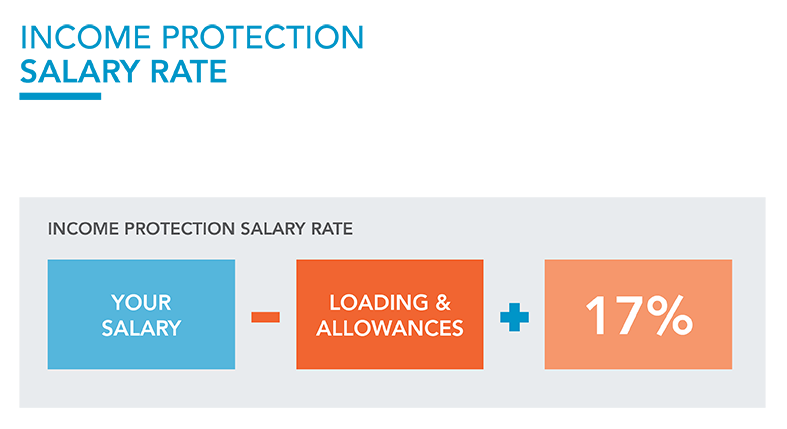The first 9 months following date of injury
During the first 9 months from your date of injury, you will receive a top-up to 100% of your normal salary from NSW Police Force. This is also the 9 month waiting period for your income protection claim if you satisfy the eligibility criteria for the income protection benefit.
As you approach nine months after the date of your injury, you will receive an income protection information package from NSW Police Force. It is important that you complete the claim forms in the package and send them back to the return address as soon as possible to enable your income protection claim to be assessed quickly.
For assistance completing the income protection forms, please contact the NSW Police Force Income Protection Unit on 02 8835 8400.
Income protection payments are made monthly in arrears. When you reach the nine-month milestone you will experience four weeks of reduced pay until your first income protection payment is made.
It is important to prepare your finances for an initial period of reduced pay.
More than nine months from date of injury
Nine months after your date of injury, you may be entitled to receive approximately 75% of your pre-injury earnings as part of your Income Protection. This benefit period is for a maximum period of seven years, or until you reach 60 years of age.
Income protection payments are managed and paid to you by TAL insurance and are in addition to your statutory rate entitlements.
Income protection payments are made monthly, four weeks in arrears and are typically the difference between the amount paid by EML and your Income Protection Salary Rate.
Your Income Protection Salary Rate is: your salary, less loading and allowances, plus 17%, except for commissioned officers.

Case study 1 – No capacity since date of injury
| Background | What payments are received? |
|---|---|
Jane sustains an injury at work and her doctor certifies her as having no capacity for work. Jane receives various forms of treatment and has preliminary discussions about returning to work. However, five months later she is still not fit for work at NSWPF. In consideration of Jane's long-term health outcomes, her doctor recommends she is medically retired from NSWPF and encourages Jane to consider alternate work options when she is fit for work. After Jane's last day of service with NSWPF she continues to have no capacity for work. | Jane is paid her normal salary by NSWPF for the period she is still employed. Up to a period of 26 weeks NSWPF recoup this at the CWWR from EML. For the period from week 27 to nine months, Jane continues to be paid her normal salary by NSWPF however they only recoup the statutory rate from EML. After Jane's last day of service with NSWPF, having satisfied the requirements for income protection, she receives the applicable statutory rate paid fortnightly from EML, plus a monthly payment (paid in arrears) from TAL topping up Jane's payments to her Income Protection Salary Rate. These payments continue until Jane either:
|
Case study 2 – Attempted return to work
| Background | What payments are received? |
|---|---|
Craig sustains an injury at work and his doctor certifies him as having no capacity for work for four weeks. Following treatment, he feels much better and is keen to get back to work. Craig's IMA helps put together a Recover at Work Plan and after four weeks off work he returns on restricted duties. After some ups and downs and 12 weeks on restricted duties, Craig consults his doctors and downgrades to having no capacity for work. Despite further treatment, Craig is unable to return to work and is recommended for medical retirement. Craig's last day of service with NSWPF is nine months after initially going off work. | Craig is paid his normal salary by NSWPF for the period he is still employed. For the first four weeks of incapacity, NSWPF recoup this at the CWWR from EML. For the period that Craig is on a Recover at Work Plan he continues to be paid his normal salary but NSWPF only recoup the s40 top up value from EML (see capacity scenarios below for more info). At the time that Craig is certified as having no capacity to work, he still has 22 weeks (26 weeks less the initial four weeks) of normal salary benefits remaining. As such, Craig continues to receive his normal salary from NSWPF who then recoup this from EML. After Craig's last day of service with NSWPF, having satisfied the requirements for income protection, he receives the applicable statutory rate paid fortnightly from EML, plus a monthly payment (paid in arrears) from TAL topping up Craig's payments to his Income Protection Salary Rate. These payments continue until Jane either:
|
Capacity for work outside of NSWPF
You have been certified by your treatment providers as having no capacity for work with the NSWPF however they have also certified you as having some capacity for work outside of the NSWPF. Let's talk about the different scenarios that might be applicable to you as you transition out of the NSWPF.
Section 38
You are entitled to 80% of your salary (Section 38) for up to 52 weeks while you are job-seeking or retraining with an approved SIRA/EML training provider. You do not need to be medically retired from NSWPF to start receiving this benefit.
Section 38 entitlements are available for a maximum of 52 weeks and you must be actively job-seeking or retraining during this time. You will be encouraged to take advantage of all available services supporting your recovery and job-seeking within the first 52 weeks, before your rate reduces to the Statutory Rate.
Section 38 and income protection entitlements
If your Section 38 entitlements are greater than your income protection entitlements, you would most likely not receive the income protection “top-up”.
You are still entitled to claim income protection following this 52-week period, unless of course, your new employment pays you more than your entitlement under income protection.
To be entitled to Section 38 payments, you must demonstrate that you are:
- ready, willing and able to accept an offer of suitable employment from an employer; and
- medically certified as having only partial incapacity for work, and partial capacity for suitable employment; and
- taking reasonable steps to obtain suitable employment.
Your return to health and return to work following injury is important for your long-term wellbeing. In either of the following scenarios your case manager will refer you to a vocational rehabilitation specialist who helps you to identify suitable career goals, retrain and secure employment when you are fit to do so.

